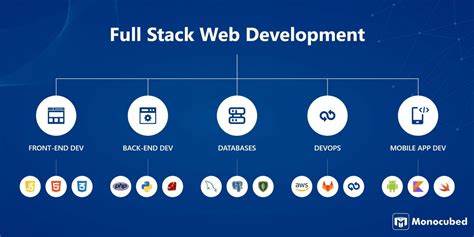Full Stack Development
What is Full Stack Development?

Full Stack Development: A Comprehensive Overview
Definition:
Full Stack Development refers to the proficiency and capability of a developer to work on both the frontend and backend aspects of a software application. In other words, a full stack developer possesses skills and expertise in multiple layers of a technology stack, allowing them to handle various aspects of the software development process. This includes both client-side (user interface) and server-side (server, database, and application) development.
Analogy:
Think of a full stack developer as a versatile chef who can not only prepare delicious dishes (frontend) but also manage the entire kitchen, from ingredients (backend) to the overall cooking process (server and database management).
Further Description:
Full stack development involves proficiency in various technologies and programming languages, such as:
Frontend Technologies: HTML, CSS, JavaScript, and frontend frameworks like React, Angular, or Vue.js.
Backend Technologies: Server-side languages like Node.js, Python, Ruby, PHP, and frameworks like Express, Django, or Flask.
Database Management: Knowledge of databases such as MySQL, PostgreSQL, MongoDB, and the ability to interact with databases using queries.
Server and Hosting Environments: Understanding server architecture, deployment, and familiarity with cloud services like AWS, Azure, or Google Cloud.
Full-stack developers are equipped to handle the entire development lifecycle, from designing user interfaces to managing databases and ensuring the seamless functioning of applications.
Why is Full Stack Development Important?
Versatility: Full stack developers can work on both frontend and backend, making them versatile and adaptable to different project requirements.
Holistic Understanding: They possess a holistic understanding of the development process, enabling them to troubleshoot issues efficiently and make informed decisions.
Collaboration: Full stack developers can collaborate more effectively with different teams, as they understand the entire software architecture.
Project Ownership: With expertise in multiple areas, full stack developers can take ownership of projects from start to finish, streamlining the development process.
Examples and Usage:
Netflix: Full stack developers at Netflix work on both the frontend (user interface) and backend (server, database) to ensure a seamless streaming experience for users.
Facebook: Facebook’s development team includes full stack developers who contribute to both the frontend (user profiles, news feeds) and backend (data storage, algorithms) aspects of the platform.
Uber: Full stack developers at Uber are involved in building and maintaining features on the user app (frontend) as well as managing the server infrastructure and databases (backend).
Key Takeaways:
- Versatility: Full stack developers possess skills in both frontend and backend development, making them versatile professionals.
- Holistic Understanding: They have a comprehensive understanding of the entire software development process, from user interface design to server management.
- Efficient Collaboration: Full stack developers can collaborate effectively with different teams, bridging the gap between frontend and backend development.
- Project Ownership: They can take ownership of projects, handling all aspects of development, which can lead to more streamlined and efficient processes.




